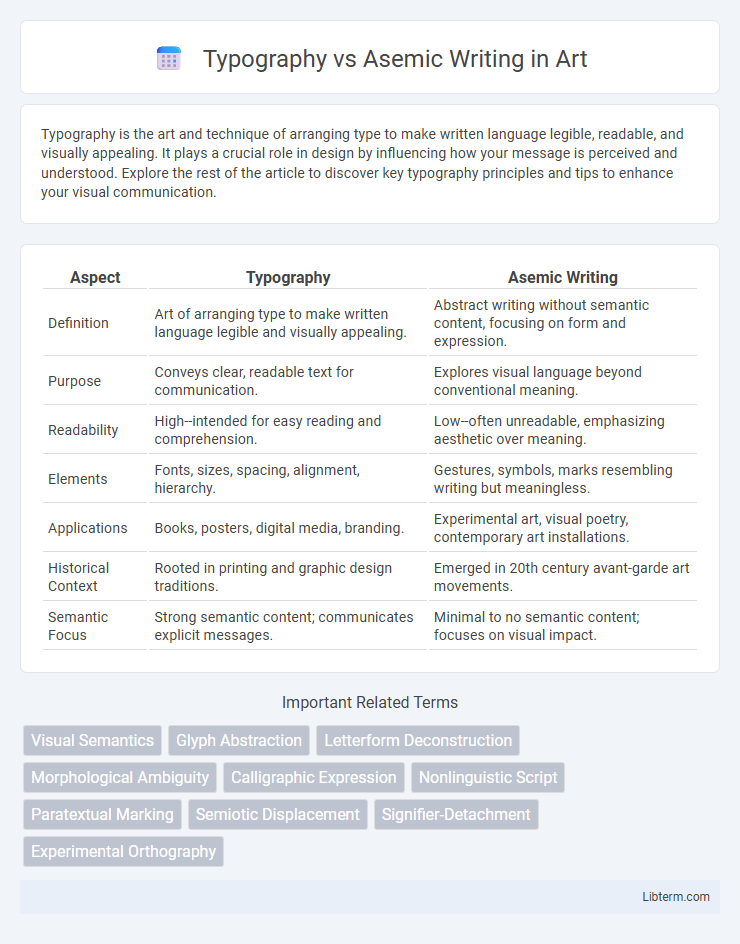Typography is the art and technique of arranging type to make written language legible, readable, and visually appealing. It plays a crucial role in design by influencing how your message is perceived and understood. Explore the rest of the article to discover key typography principles and tips to enhance your visual communication.
Table of Comparison
| Aspect | Typography | Asemic Writing |
|---|---|---|
| Definition | Art of arranging type to make written language legible and visually appealing. | Abstract writing without semantic content, focusing on form and expression. |
| Purpose | Conveys clear, readable text for communication. | Explores visual language beyond conventional meaning. |
| Readability | High--intended for easy reading and comprehension. | Low--often unreadable, emphasizing aesthetic over meaning. |
| Elements | Fonts, sizes, spacing, alignment, hierarchy. | Gestures, symbols, marks resembling writing but meaningless. |
| Applications | Books, posters, digital media, branding. | Experimental art, visual poetry, contemporary art installations. |
| Historical Context | Rooted in printing and graphic design traditions. | Emerged in 20th century avant-garde art movements. |
| Semantic Focus | Strong semantic content; communicates explicit messages. | Minimal to no semantic content; focuses on visual impact. |
Introduction to Typography and Asemic Writing
Typography involves the art and technique of arranging type to make written language legible, readable, and visually appealing, focusing on font choice, size, line length, and spacing. In contrast, asemic writing is a form of wordless open semantic form where the marks resemble writing but lack specific semantic content, often used as an abstract visual art form. Both explore communication through text, with typography emphasizing clarity and function while asemic writing prioritizes expressive, non-literal visual aesthetics.
Defining Typography: Art and Function
Typography is the art and technique of arranging type to make written language visually appealing and legible, combining elements such as font choice, size, spacing, and layout to enhance communication. It serves both functional purposes--improving readability and user experience--and artistic expression through creative design. Unlike asemic writing, which is intentionally devoid of semantic content, typography emphasizes clarity and the conveyance of meaning through structured visual form.
What is Asemic Writing? Origins and Concepts
Asemic writing is an abstract form of writing that lacks specific semantic content, making it open to interpretation without being tied to any known language or script. Originating in the 20th century through avant-garde movements such as Dadaism and Surrealism, it challenges traditional notions of meaning and communication by emphasizing visual expression over linguistic structure. Unlike typography, which uses defined characters and fonts to convey precise textual information, asemic writing blurs the line between writing and art, prioritizing form, texture, and gesture.
Visual Communication: Typography vs Asemic Writing
Typography uses structured letterforms and spacing to convey clear linguistic messages, enhancing readability and brand identity in visual communication. Asemic writing employs abstract, wordless marks that evoke emotional responses and artistic interpretation, prioritizing visual aesthetics over direct language comprehension. Both methods leverage visual elements to engage viewers, but typography emphasizes meaning clarity while asemic writing fosters open-ended, imaginative interaction.
The Role of Legibility in Typography and Asemic Scripts
Legibility in typography is essential for clear communication, enabling readers to quickly recognize and interpret characters based on standardized letterforms and spacing. In contrast, asemic writing prioritizes visual expression over readability, featuring marks and symbols that evoke meaning without relying on conventional textual comprehension. The distinct roles of legibility shape typography as a functional tool for conveying information, while asemic scripts serve as abstract, interpretive art forms.
Historical Evolution: From Letters to Gestures
Typography evolved from the invention of movable type in the 15th century, revolutionizing the way letters and texts were reproduced and standardized in print culture. Asemic writing emerged in the late 20th century as a form of abstract, wordless communication that emphasizes visual gestures over conventional letterforms. This shift from structured typography to gestural asemic marks highlights the historical evolution from literal, semantic text to expressive, non-linguistic signs in visual art.
Aesthetic Considerations in Both Practices
Typography emphasizes structured letterforms, precise spacing, and legibility to create visually appealing and readable text that conveys clear information. Asemic writing, by contrast, prioritizes abstract, pictorial, or calligraphic elements that evoke emotional or aesthetic responses without relying on semantic content. Both practices balance form and visual rhythm, where typography harnesses consistency for clarity and asemic writing explores freeform expression to engage viewers through ambiguity and artistic interpretation.
Emotional Impact and Reader Interpretation
Typography harnesses structured letterforms and font styles to evoke emotions through visual hierarchy, clarity, and aesthetic appeal, guiding reader interpretation with intentional design choices. Asemic writing, devoid of semantic content, relies on abstract shapes and marks to provoke emotional responses rooted in ambiguity, inviting highly personal and subjective interpretation. The emotional impact of typography is anchored in recognizable language cues, while asemic writing stimulates imagination and introspection through its open-ended visual language.
Applications in Contemporary Art and Design
Typography in contemporary art and design emphasizes structured letterforms and legibility, serving functional purposes in branding and communication. Asemic writing, conversely, employs abstract, wordless marks that prioritize visual expression over semantic clarity, often evoking emotional or interpretive responses. Both forms challenge traditional text use, with typography reinforcing identity and asemic writing exploring the boundaries of written language as art.
Conclusion: Bridging Language and Expression
Typography uses structured letters and fonts to communicate specific linguistic meanings clearly, while asemic writing embraces abstract marks that evoke emotion and personal interpretation. Bridging language and expression involves recognizing how both forms enrich visual communication by blending clarity with creative ambiguity. This fusion expands the boundaries of written art, allowing deeper connections between the reader's perception and the creator's intent.
Typography Infographic

 libterm.com
libterm.com